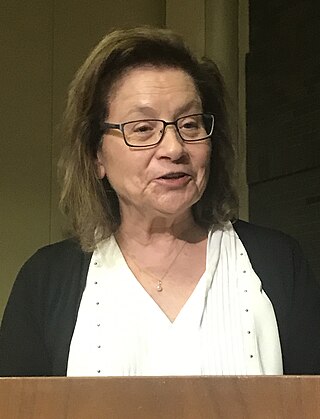Related Research Articles

American Sign Language (ASL) is a natural language that serves as the predominant sign language of Deaf communities in the United States of America and most of Anglophone Canada. ASL is a complete and organized visual language that is expressed by employing both manual and nonmanual features. Besides North America, dialects of ASL and ASL-based creoles are used in many countries around the world, including much of West Africa and parts of Southeast Asia. ASL is also widely learned as a second language, serving as a lingua franca. ASL is most closely related to French Sign Language (LSF). It has been proposed that ASL is a creole language of LSF, although ASL shows features atypical of creole languages, such as agglutinative morphology.

Sign languages are languages that use the visual-manual modality to convey meaning, instead of spoken words. Sign languages are expressed through manual articulation in combination with non-manual markers. Sign languages are full-fledged natural languages with their own grammar and lexicon. Sign languages are not universal and are usually not mutually intelligible, although there are also similarities among different sign languages.
Nicaraguan Sign Language is a form of sign language which developed spontaneously among deaf children in a number of schools in Nicaragua in the 1980s. It is of particular interest to linguists as it offers them a unique opportunity to study what they believe to be the birth of a new language.

Deaf culture is the set of social beliefs, behaviors, art, literary traditions, history, values, and shared institutions of communities that are influenced by deafness and which use sign languages as the main means of communication. When used as a cultural label especially within the culture, the word deaf is often written with a capital D and referred to as "big D Deaf" in speech and sign. When used as a label for the audiological condition, it is written with a lower case d. Carl G. Croneberg coined the term "Deaf Culture" and he was the first to discuss analogies between Deaf and hearing cultures in his appendices C/D of the 1965 Dictionary of American Sign Language.
Audism as described by deaf activists is a form of discrimination directed against deaf people, which may include those diagnosed as deaf from birth, or otherwise. Tom L. Humphries coined the term in his doctoral dissertation in 1975, but it did not start to catch on until Harlan Lane used it in his writing. Humphries originally applied audism to individual attitudes and practices; whereas Lane broadened the term to include oppression of deaf people.
Providence Island Sign Language is a village sign language of the small island community of Providence Island in the Western Caribbean, off the coast of Nicaragua but belonging to Colombia. The island is about 15 square miles (39 km2) and the total population is about 5000, of which an unusual proportion are deaf.
Pamela Munro is an American linguist who specializes in Native American languages. She is a distinguished research professor emeritus of linguistics at the University of California, Los Angeles, where she has held a position since 1974.
California Cultures in Comparative Perspective is a program at the University of California, San Diego in California dedicated to fostering creative and activist interdisciplinary research, teaching, and collaboration among California's communities, faculty, and students. California – in all its dimensions—is the object of its focus.
In the United States, deaf culture was born in Connecticut in 1817 at the American School for the Deaf, when a deaf teacher from France, Laurent Clerc, was recruited by Thomas Gallaudet to help found the new institution. Under the guidance and instruction of Clerc in language and ways of living, deaf American students began to evolve their own strategies for communication and for living, which became the kernel for the development of American Deaf culture.
Sige-Yuki Kuroda, also known as S.-Y. Kuroda, was Professor Emeritus and Research Professor of Linguistics at the University of California, San Diego. Although a pioneer in the application of Chomskyan generative syntax to the Japanese language, he is known for the broad range of his work across the language sciences. For instance, in formal language theory, the Kuroda normal form for context-sensitive grammars bears his name.
Margaret Langdon was a US linguist who studied and documented many languages of the American Southwest and California, including Kumeyaay, Northern Diegueño (Ipai), and Luiseño.
Tom L. Humphries is an American academic, author, and lecturer on Deaf culture and deaf communication. Humphries is a professor at the University of California, San Diego (UCSD).
A Man Without Words is a book by Susan Schaller, first published in 1991, with a foreword by author and neurologist Oliver Sacks. The book is a case study of a 27-year-old deaf man whom Schaller teaches to sign for the first time, challenging the Critical Period Hypothesis that humans cannot learn language after a certain age.
Claire L Ramsey is an American linguist. Ramsey is an Associate Professor Emerita at the University of California, San Diego. She is an alumna of Gallaudet University and is former instructor at the University of Nebraska in Lincoln, Nebraska. Ramsey's research has focused on the sociolinguistics of deaf and signing communities in the US and Mexico.

Audree Lauraine Norton was a deaf actress and educator. She was born in Great Falls, Montana and raised in Minnesota.
Language acquisition is a natural process in which infants and children develop proficiency in the first language or languages that they are exposed to. The process of language acquisition is varied among deaf children. Deaf children born to deaf parents are typically exposed to a sign language at birth and their language acquisition follows a typical developmental timeline. However, at least 90% of deaf children are born to hearing parents who use a spoken language at home. Hearing loss prevents many deaf children from hearing spoken language to the degree necessary for language acquisition. For many deaf children, language acquisition is delayed until the time that they are exposed to a sign language or until they begin using amplification devices such as hearing aids or cochlear implants. Deaf children who experience delayed language acquisition, sometimes called language deprivation, are at risk for lower language and cognitive outcomes. However, profoundly deaf children who receive cochlear implants and auditory habilitation early in life often achieve expressive and receptive language skills within the norms of their hearing peers; age at implantation is strongly and positively correlated with speech recognition ability. Early access to language through signed language or technology have both been shown to prepare children who are deaf to achieve fluency in literacy skills.
Deafness has varying definitions in cultural and medical contexts. In medical contexts, the meaning of deafness is hearing loss that precludes a person from understanding spoken language, an audiological condition. In this context it is written with a lower case d. It later came to be used in a cultural context to refer to those who primarily communicate through sign language regardless of hearing ability, often capitalized as Deaf and referred to as "big D Deaf" in speech and sign. The two definitions overlap but are not identical, as hearing loss includes cases that are not severe enough to impact spoken language comprehension, while cultural Deafness includes hearing people who use sign language, such as children of deaf adults.

Wendy Sandler is an American-Israeli linguist who is known for her research on the phonology of Sign Languages.

Rachel I. Mayberry is a language scientist known for her research on the effects of age of acquisition on sign language acquisition among deaf individuals – research that has provided evidence for a critical period in first language acquisition. She is Professor of Linguistics at University of California, San Diego (UCSD) and director of the Multimodal Language Lab.
Karen Denise Emmorey is a linguist and cognitive neuroscientist known for her research on the neuroscience of sign language and what sign languages reveal about the brain and human languages more generally. Emmorey holds the position of Distinguished Professor in the School of Speech, Language, and Hearing Sciences at San Diego State University, where she directs the Laboratory for Language and Cognitive Neuroscience and the Center for Clinical and Cognitive Neuroscience.
References
- ↑ "Home | Carol Padden". Communication.ucsd.edu. Archived from the original on 2010-12-03. Retrieved 2010-09-28.
- 1 2 3 Padden, Carol and Humphries, Tom. Deaf in America: Voices from A Culture, page 1
- ↑ "Q & A Padden Humphries", UC San Diego
- ↑ Padden, Carol A., and Tom L. Humphries. Inside Deaf Culture. page 151
- ↑ "GU Graduate Receives MacArthur 'Genius Grant'". 2010-10-05. Retrieved 2023-02-24.
- ↑ "UC San Diego – Linguistics People – Alumni". linguistics.ucsd.edu. Retrieved 2023-02-24.
- ↑ Padden, Carol A. (1988). Interaction of morphology and syntax in American sign language. Outstanding dissertations in linguistics. New York: Garland. ISBN 978-0-8240-5194-5.
- ↑ "Transcript: An Exploration of Deaf Culture", NPR, February 2, 2005
- ↑ "Carol A. Padden – John Simon Guggenheim Memorial Foundation". Gf.org. Archived from the original on 2011-06-22. Retrieved 2010-09-28.
- ↑ Lee, Felicia. "MacArthur Foundation Honors 23," New York Times. September 28, 2003.
- ↑ "LSA Fellows by Year of Induction | Linguistic Society of America". www.linguisticsociety.org. Retrieved 2023-02-24.
- ↑ WorldCat Identities Archived December 30, 2010, at the Wayback Machine : Padden, Carol